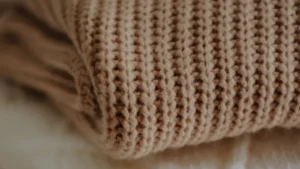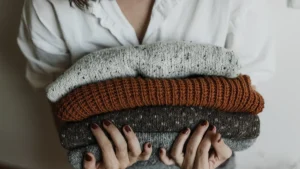
When considering fleece versus wool, it’s important to know that wool keeps you warmer than fleece in very cold conditions because it retains heat better, even when wet. However, fleece versus wool is not a simple comparison—fleece dries quickly and feels lightweight, which is why many outdoor enthusiasts prefer it. Both fleece versus wool have their own advantages, so your choice depends on what you need for your trip.
Key Takeaways
Wool keeps you warmer than fleece in wet or very cold conditions because it traps heat even when damp.
Fleece dries faster, feels lighter, and works best for active days in dry, cold weather.
Layering wool as a base and fleece as a mid-layer combines warmth, quick drying, and odor control.
Wool resists odors and lasts longer but needs gentle care; fleece is soft, easy to wash, and budget-friendly.
Choose wool for wet, multi-day trips and fleece for high-energy, short adventures based on your activity and weather.
Warmth and Insulation

Heat Retention
When you want to stay warm in cold weather, you need to think about how well your clothes trap heat. Both wool and fleece work as an insulating layer, but they do it in different ways. Wool has natural fibers that trap air, which helps keep your body heat close. Fleece uses synthetic fibers and a fluffy texture to create air pockets, too. These air pockets are what give both materials their insulation.
You might wonder how much insulation you actually get from each. Clothing experts use something called a “clo” value to measure insulation. Here’s a quick look at how different wool and fleece garments compare:
Garment Type | Approximate R-value (m²·K/W) | |
|---|---|---|
Wool pants (half long legs) | 0.06 | 0.009 |
Flannel shirt (wool-like) | 0.30 | 0.047 |
Flannel trousers (wool-like) | 0.28 | 0.043 |
Quilted fleece slippers | 0.03 | 0.005 |
Thin sweater (possibly wool) | 0.20 | 0.031 |
Thick sweater (possibly wool) | 0.35 | 0.054 |
You can see that thicker wool sweaters offer more insulation than thin ones. Fleece slippers have a lower clo value, so they provide less warmth. The best protection from the elements often comes from choosing the right thickness and layering your clothes.
Fleece and wool both trap heat by holding air in their fibers. The thickness and weight of the fabric matter a lot. Thicker and heavier fleece, for example, keeps you warmer because it holds more air. Patterns in fleece, like a 3:1 knit, can also boost heat retention. Wool, on the other hand, naturally adjusts to your body temperature and keeps you comfortable in a range of conditions.
Here’s a chart that shows how different garments stack up in terms of insulation:
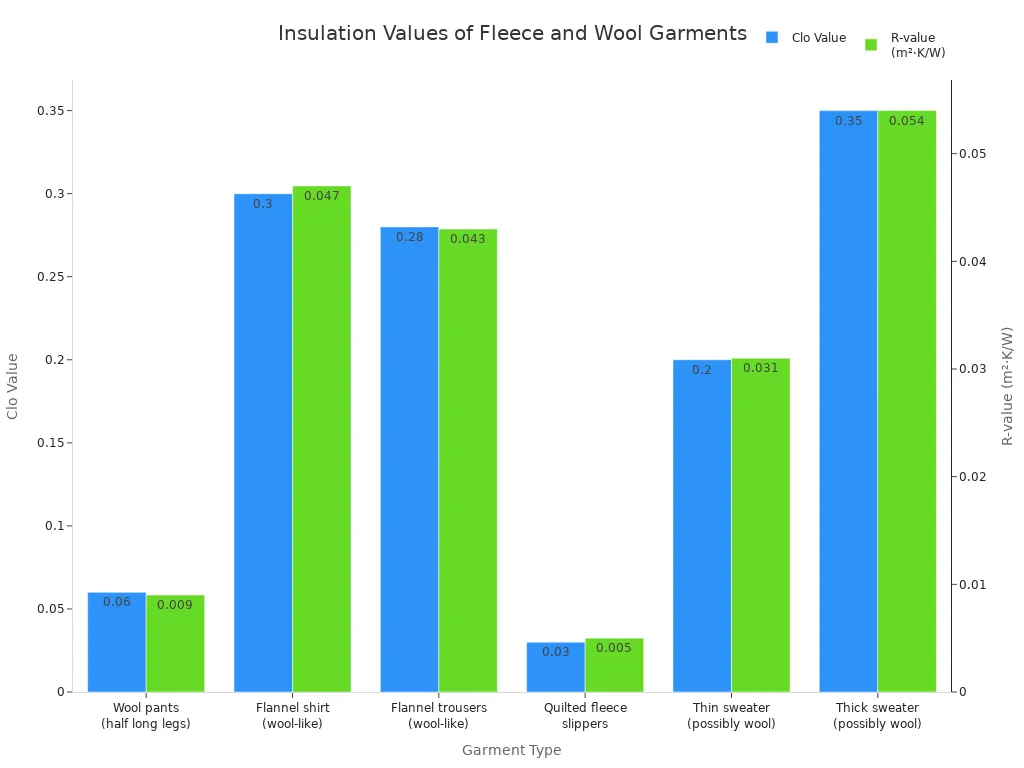
Tip: If you want the best protection from the elements, try to layer a thick wool sweater over a lighter fleece. This combo gives you the benefits of both materials.
Extreme Cold Performance
When you face extreme cold, you need an insulating layer that keeps you warm even if things get wet. Wool shines here. Thanks to its natural lanolin, wool keeps its insulation even when damp. You can get caught in a snowstorm, and your wool sweater will still help you hold onto your warmth. Fleece dries much faster than wool, but it loses some of its insulating power when wet.
Let’s break down how each material performs in tough conditions:
Wool keeps you warm even when it gets wet. The fibers hold heat and resist getting soaked.
Fleece dries quickly, so if you sweat or get splashed, you won’t stay wet for long.
Wool is heavier when it’s wet, but it still works as an insulating layer.
Fleece is lighter and lets heat escape faster, which is good if you’re moving a lot and don’t want to overheat.
Both materials trap heat by holding air, but wool holds onto warmth longer, especially when you stop moving.
Field tests and expert reviews agree: wool gives you the best insulating layer for extreme cold, especially if you might get wet. Fleece works well for high-energy activities in dry cold, like hiking or skiing. If you want to stay warm during long periods of rest or in damp weather, wool is your friend.
Note: Many outdoor experts suggest wearing both wool and fleece together. Start with a wool base layer for insulation, then add a fleece mid-layer for extra warmth and quick drying. This system gives you flexibility and the best chance to stay comfortable in any weather.
Fleece Versus Wool
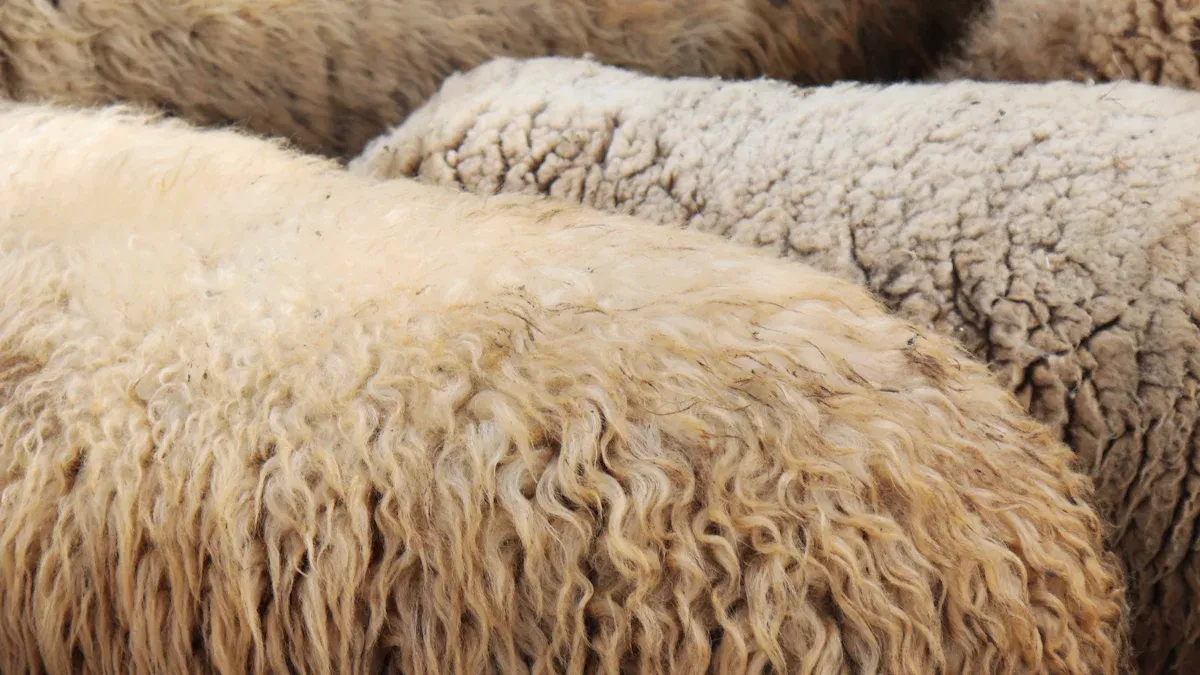
Material Differences
When you compare fleece versus wool, you notice some big differences in how each material is made and how it works to keep you warm. Wool comes straight from sheep. It’s a natural fiber packed with proteins like α-keratin. These proteins form a complex structure with overlapping scales on the outside and a fluffy, elastic core inside. This unique design creates lots of tiny air pockets. These air pockets trap heat and help wool insulate your body, even if you get wet. Wool can soak up to 30% of its weight in moisture and still feel warm, thanks to its lanolin and moisture-wicking abilities.
Fleece, on the other hand, is a synthetic material. Manufacturers make fleece from polyester fibers and brush it to feel soft and fluffy, almost like wool. Fleece doesn’t have the same protein structure or natural crimp as wool. Instead, it relies on its lightweight, airy weave to trap heat. Fleece dries much faster than wool, but it loses some insulation if it gets soaked. You’ll find fleece easy to wash and care for, and it doesn’t shrink like wool sometimes does.
Here’s a quick table to help you see the main differences:
Feature | Wool | Fleece |
|---|---|---|
Source | Natural (sheep) | Synthetic (polyester) |
Structure | Protein-based, crimped, elastic | Smooth, brushed synthetic fibers |
Insulation | Excellent, even when wet | Good, but drops when wet |
Moisture Handling | Absorbs, wicks, insulates when damp | Repels, dries quickly, loses warmth |
Odor Resistance | High | Low |
Care | Needs gentle washing, may shrink | Easy care, machine washable |
Feel | Can be itchy, softer in merino varieties | Soft, non-irritating |
Tip: If you want a material that keeps you warm in wet, windy weather, wool’s natural structure gives it the edge. For quick-drying comfort, fleece is your friend.
Best Uses
You might wonder when to pick fleece versus wool for your next adventure. The answer depends on what you plan to do and the weather you expect.
Fleece shines in dry, cold conditions. If you’re hiking, running, or doing any high-energy activity, fleece keeps you comfortable. It’s lightweight, packs down small, and dries in a flash if you sweat. Many people with sensitive skin love fleece because it feels soft and never itchy. Fleece and wool apparel both have their place, but fleece is often the go-to for short trips, budget-friendly gear, or when you need something easy to wash.
Wool works best in damp, cold, or unpredictable weather. Wool keeps you warm even if you get caught in rain or snow. It’s perfect for stop-and-go activities, like hunting from a tree stand or taking breaks on a winter hike. Wool resists odors, so you can wear it for days without worrying about smell. Merino wool, in particular, feels soft and less itchy, making it a favorite for base layers.
Let’s break it down with a list:
Choose fleece when:
You need lightweight, quick-drying layers.
You plan to move a lot and want breathability.
You have sensitive skin or want something soft.
You want affordable, easy-care clothing.
You’re heading out for a short, active trip.
Choose wool when:
You expect wet, damp, or windy weather.
You need insulation that works even when wet.
You want to avoid odors on long trips.
You’ll be stopping and starting, not always moving.
You want natural fibers and better temperature control.
Many outdoor experts suggest mixing both materials for the best results. You can wear a wool base layer for warmth and odor control, then add a fleece mid-layer for extra insulation and fast drying. This combo covers you for almost any cold-weather adventure.
Note: In the fleece vs wool debate, there’s no single winner. Your best choice depends on your activity, the weather, and what feels good on your skin. Try different combinations to see what works for you!
Pros and Cons of Wool and Fleece
Wool Pros and Cons
When you look at the pros and cons of wool and fleece, you’ll see that wool stands out for warmth and comfort in cold weather. Many outdoor gear reviews highlight these points:
Wool gives you excellent insulation and helps regulate your temperature. You stay warm when it’s cold, but you don’t overheat if you start moving.
Wool base layers wick moisture away from your skin and keep you warm, even if you get sweaty or damp.
You don’t have to worry about odor with wool. It naturally resists smells, so you can wear it for days without washing.
Merino wool feels soft and comfortable next to your skin. You won’t get that itchy feeling you might remember from old wool sweaters.
Wool works well as a base, mid, or even outer layer. It protects you from wind, rain, and snow.
Wool keeps you warmer than fleece, especially if you run cold or spend a lot of time outdoors.
Some people find wool itchy, especially if it’s not Merino or a fine blend.
Wool dries slowly. If you get soaked, you might feel damp for a while.
You need to wash wool carefully. It can shrink or lose shape if you use hot water or a dryer.
Wool costs more than fleece and doesn’t last as long if you wear it hard.
Tip: If you want a layer that keeps you warm, resists odor, and feels soft, Merino wool is a great choice. Just remember to care for it gently.
Fleece Pros and Cons
Fleece has its own set of strengths and weaknesses. Here’s a quick look at the pros and cons of wool and fleece, focusing on fleece:
Pros of Fleece | Cons of Fleece (Environmental Focus) |
|---|---|
Provides good insulation and warmth | Not biodegradable; stays in landfills for years |
Lightweight and easy to layer | Sheds microfibers during washing (plastic pollution) |
Soft and comfortable on your skin | Polyester production releases greenhouse gases |
Durable and keeps its shape | Uses chemicals that can harm health and nature |
Wicks moisture and dries quickly | Produces water pollution during manufacturing |
Hypoallergenic and easy to care for | |
Affordable and comes in many styles |
You’ll notice that fleece keeps you warm, feels soft, and dries fast. You can toss it in the wash without worry. Fleece costs less than wool and lasts longer if you use it often. On the downside, fleece isn’t great for the environment. It sheds tiny plastic fibers and doesn’t break down in landfills.
Note: If you want something easy to care for, soft, and budget-friendly, fleece is a solid pick. Just keep the environmental impact in mind.
Moisture and Breathability
Wicking
When you get active in cold weather, your clothes need to handle sweat. You want your layers to pull moisture away from your skin so you stay dry and warm. This is where wicking comes in. Wicking means moving sweat from your skin to the outside of the fabric, where it can evaporate.
Let’s talk about how fleece and wool handle this job. Laboratory tests show that wool fibers, like merino and alpaca, have a special structure. The outside of each fiber does not let water move easily, so sweat does not travel quickly through the fabric. Instead, moisture gets trapped inside the wool fibers and stays there until it evaporates. This means wool does not wick sweat as fast as you might hope.
Fleece, made from polyester, works differently. It does not soak up water into the fibers. Instead, it moves sweat along the surface and away from your skin. This makes fleece much better at wicking moisture. You will feel drier and more comfortable during high-energy activities.
If you sweat a lot or move fast, fleece will keep you feeling dry. Wool is still cozy, but it holds onto more moisture.
Drying Speed
After your clothes get wet, you want them to dry quickly. This helps you stay warm and comfortable. Scientists have tested how long it takes for fleece and wool to dry after getting soaked.
Here’s a table that shows what happens when different fabrics get wet:
Fabric | Weight Before Wetting (g) | Weight After Wetting (g) | Water Absorbed (g) | Drying Time (min) | Drying Time per g Water (min/g) |
|---|---|---|---|---|---|
Pata | 12 | 47 | 35 | 65 | 1.86 |
GL | 10 | 54 | 44 | 75 | 1.71 |
Ibex | 14 | 59 | 45 | 90 | 2.00 |
IB | 18 | 63 | 45 | 90 | 2.00 |
SW | 14 | 68 | 54 | 100 | 1.85 |
You can see that wool fabrics, like Smartwool (SW), soak up more water and take longer to dry. Fleece fabrics dry faster because they do not hold as much water. But if you look at the drying time per gram of water, both wool and fleece dry at almost the same rate.
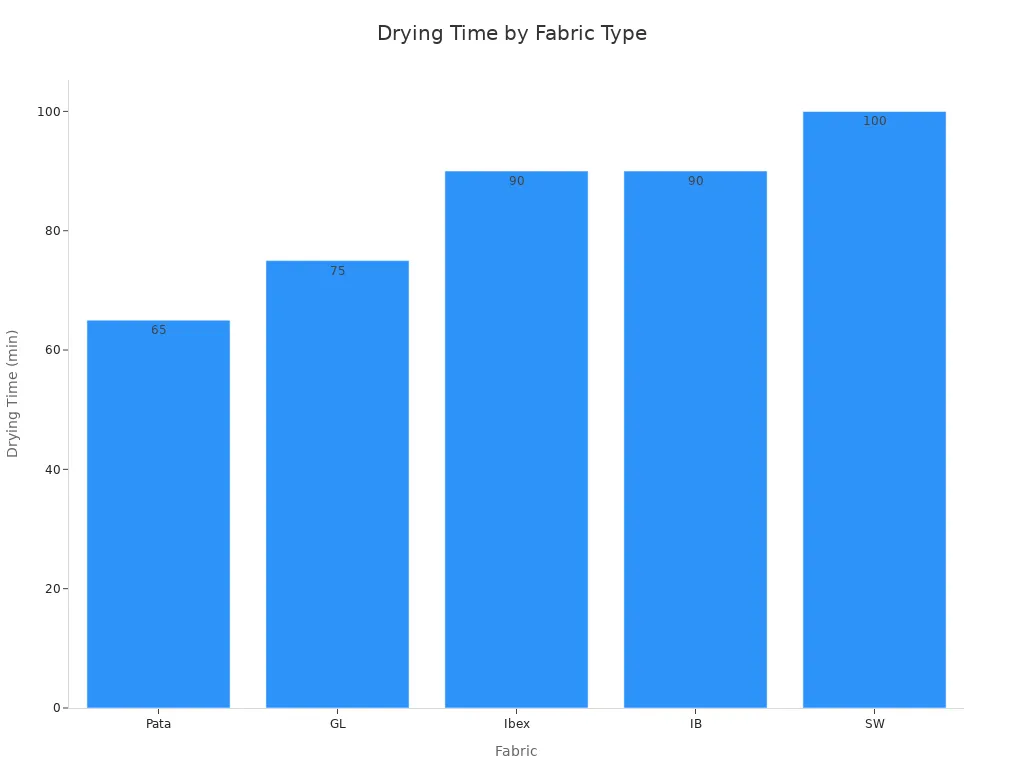
So, what does this mean for you? Wool will feel heavier and wetter if you get caught in the rain or sweat a lot. Fleece will dry out faster and feel lighter. Still, both materials dry at a similar speed for each gram of water they hold. The big difference is that wool just holds more water.
Tip: If you want your layers to dry fast after getting wet, choose fleece. Wool will keep you warm, but you may need to wait longer for it to dry out.
Odor and Comfort
Odor Resistance
If you have ever worn the same shirt for days, you know how important odor resistance can be. Wool stands out here. It has natural antibacterial properties that fight off smells. You can wear a merino wool shirt for many days, and people around you will not notice any odor. Some people have even worn the same merino wool shirt for 100 days straight without washing it, and still, no one noticed a smell. Wool socks also help keep your feet fresh. They absorb moisture and stop foot odor, which is great if you are active or on your feet all day.
Fleece does not perform as well in this area. It can trap sweat and start to smell after just a day or two. You might need to wash fleece more often to keep it fresh. If you want to avoid odor on long trips or during busy weeks, wool is the better choice.
Merino wool destroys odors, so you can wear it longer without washing.
Wool socks help prevent athlete’s foot and keep feet smelling fresh.
Fleece tends to hold onto sweat and can smell faster.
Tip: For multi-day adventures or busy schedules, choose wool for its odor-fighting power.
Feel and Sensitivity
When you put on a layer, you want it to feel good against your skin. Many people love the soft, light touch of fleece. It feels cozy and gentle, especially when you first wear it. Fleece is easy to care for and rarely causes itching. However, it does not wick moisture as well as wool, so you might feel damp or sticky after a while.
Wool offers natural moisture-wicking and keeps you warm. It also has antimicrobial benefits, which add to your comfort. Some people with sensitive skin find wool itchy, especially if the fibers are thick. Merino wool uses finer fibers, so it feels much softer and works well for most people. Scientific tests show that finer wool fibers cause less prickle and discomfort. If you have allergies or very delicate skin, you might still prefer fleece for its smooth feel.
Most users say wool keeps them warmer and lasts longer. Fleece feels softer at first but can get uncomfortable if it stays damp. You should try both and see which one feels best for you.
Weight and Durability
Packability
When you pack for a trip, you want your clothes to fit easily in your bag. Fleece and wool both keep you warm, but they pack very differently. Fleece usually wins when it comes to saving space. Lightweight fleece jackets roll up small and fit into tight spaces in your backpack. Even midweight fleece layers stay pretty compact, though they get a bit bulkier. Heavyweight fleece, though, can take up a lot of room and feels less flexible.
Wool sweaters, especially the classic thick ones, can be a challenge. They often pack down to the size of a small cantaloupe. Some special wool blends, like merino or cashmere, compress better—sometimes as small as a 1-liter water bottle. Still, most wool layers feel heavier and less squishable than fleece.
Here’s a quick look at how fleece and wool stack up for packability:
Layer Type | Packability | Typical Use | Notes |
|---|---|---|---|
Lightweight Fleece | Very packable | Base or mid layer | Breathable, easy to stuff in a bag |
Midweight Fleece | Moderately packable | Mid layer | Warmer, a bit bulkier |
Heavyweight Fleece | Bulky | Outer layer | Not ideal for packing |
Fine Wool (Merino) | Packable | Base or mid layer | Compresses well, softer feel |
Traditional Wool | Bulky | Mid or outer layer | Hard to compress, takes up more space |
Fleece is machine washable and dries fast, so you can pack it away even after a rainy hike.
Wool resists odor, so you might pack fewer layers, but it takes up more space.
Tip: If you want to save space and keep your bag light, go with lightweight fleece. For longer trips where you need fewer washes, merino wool is a smart pick.
Longevity
You want your cold-weather gear to last, especially if you use it a lot. Wool stands out for durability. Studies show that wool garments last about 6 years with regular use. That’s longer than cotton and many synthetic fabrics. Wool fibers can bend over 20,000 times before breaking. This means your wool sweater can handle lots of stretching, packing, and wearing without falling apart.
Wool also resists odor, so you don’t need to wash it as often. Less washing means less wear and tear, which helps your wool clothes last even longer. Fleece is tough, too. It keeps its shape and stands up to lots of washes. However, over time, fleece can pill or get thin, especially if you wear it under heavy backpacks.
Wool lasts longer and stays looking good, even after years of use.
Fleece is easy to care for and holds up well, but may show wear sooner.
Note: If you want a layer that goes the distance, wool is a great investment. Fleece is still a solid choice for everyday adventures, especially if you like easy care and quick drying.
Cost and Value
Price
When you shop for cold weather layers, price often plays a big role in your decision. Wool and fleece both come in a wide range of prices, especially from well-known outdoor brands. You might notice that wool base layers usually cost more than fleece, but both can get expensive if you look at technical or outerwear pieces.
Here’s a quick look at typical prices for fleece and wool garments:
Garment Type | Example Product Name | Price (USD) |
|---|---|---|
Wool Base Layer | Lady Wool Sports Top | $79.95 |
Wool Base Layer | Women’s Super Thermo Long Sleeve Shirt | $79.95 |
Wool Base Layer (Technical/Heavier) | Arctic Longs Base Layer with Fly | $149.95 |
Polar Fleece | Polar Vest with Windstopper | $179.95 |
Outerwear (Jacket) | Antarctic Jacket with Front Windstopper | $339.95 |
Outerwear (Pants) | Men’s Adventure Softshell Pant | $399.95 |
Accessories | 70 Gram Lined Hat | $47.95 |
You can see that base layers usually fall between $80 and $150. Outerwear can reach $400 or more. Fleece and wool both have options at different price points, but wool often costs a bit more for similar items.

Tip: If you want to save money, look for sales or consider lighter layers. Accessories like hats and gloves are usually the most affordable way to try wool or fleece.
Investment
When you think about value, you want to know if your gear will last and if it’s worth the price. Wool and fleece both offer good value, but in different ways.
Wool is biodegradable and more sustainable. Many brands use ethical production methods.
Wool fibers are strong and last a long time, but they need gentle care.
Fleece is usually more affordable and resists wear and tear.
Many fleece items now use recycled materials, but fleece is not as eco-friendly as wool.
Wool needs special washing and air drying to keep its shape. Fleece is easy to wash and dry.
Wool stands out for its natural water resistance and ability to keep you warm even when damp. You can wear wool for many seasons, and it doesn’t need washing as often because it resists odors. Fleece is tough, easy to care for, and lasts through lots of washes, but it can pill over time.
Wool’s higher price pays off if you want a layer that works in many conditions and lasts for years. Fleece gives you a budget-friendly option that’s easy to use every day. Both are smart investments, depending on what matters most to you—sustainability, durability, or price.
Note: If you want gear that lasts and supports the planet, wool is a great choice. If you want something easy and affordable, fleece is hard to beat.
Layering Tips
Wool as Base Layer
When you start building your cold weather outfit, always begin with a good base layer. Wool works best here, especially merino wool. It feels soft, fits close to your skin, and keeps you dry by pulling sweat away. You want your base layer to fit snugly but not too tight. This helps with moisture-wicking and keeps you comfortable all day.
Merino wool base layers stand out because they breathe well and trap heat. They also fight odors, so you can wear them for days without washing. If you plan to hike, ski, or camp, wool makes a smart choice for your first layer. Remember to follow care instructions. Wash your wool base layer gently and let it air dry to keep it in top shape.
Tip: Avoid cotton as a base layer. Cotton holds moisture and makes you feel cold. Stick with wool or synthetic options for the best results.
Fleece as Mid Layer
After your base layer, add a mid layer for extra warmth. Fleece is a favorite for this spot. It feels light, dries fast, and keeps you warm without making you sweat. You can pick from lightweight, midweight, or heavyweight fleece, depending on how cold it is and how active you plan to be.
If you move a lot, like when skiing or climbing, choose a slim, lightweight fleece. For really cold days or when you want to relax, go for a thicker fleece. Fleece base layers are not common, but fleece as a mid layer works great for most people. Just remember, fleece lets wind through, so you may need a windproof jacket on top.
Fleece Weight | Best Use | Features |
|---|---|---|
Lightweight | High activity, mild cold | Breathable, packable |
Midweight | Most cold days, general use | Warm, versatile |
Heavyweight | Very cold, casual use | Bulky, very warm |
Combining Layers
You get the best protection when you combine wool and fleece. Start with a wool base layer to manage sweat and control odor. Add a fleece mid layer for insulation and quick drying. Top it off with a windproof or waterproof jacket to block the elements.
Here’s a simple layering system many outdoor experts recommend:
Put on a merino wool base layer for warmth and moisture control.
Add a fleece mid layer for extra insulation and breathability.
Finish with a weatherproof outer layer to keep out wind and rain.
This system works for hiking, skiing, or just staying warm outside. You can adjust the thickness of each layer based on the weather and your activity. If you get too warm, take off a layer. If you feel cold, add one back.
Remember: Layering lets you adapt to changing weather. Wool and fleece together make a strong team for any cold adventure. Choose each warm clothing layer based on your needs and comfort.
When to Choose
Wet vs. Dry Conditions
Choosing between wool and fleece often comes down to the weather you expect. If you know you’ll face damp, rainy, or snowy conditions, wool is your best friend. Wool keeps you warm even when it gets wet. It absorbs moisture but still traps heat, so you stay comfortable during long, cold days. Many hikers and campers love wool for multi-day trips because it resists odor and stays warm, even if it takes about 12 hours to dry out. Fleece, on the other hand, shines in dry weather. It dries super fast—sometimes in just 15 minutes—and feels light on your body. If you get caught in a sudden downpour, fleece won’t keep you as warm as wool, but it will dry out quickly once the rain stops. Here’s a quick comparison:
Condition | Wool | Fleece |
|---|---|---|
Wet & Cold | Stays warm, dries slowly | Loses warmth, dries fast |
Dry & Cold | Very warm, heavier | Warm, lightweight |
Multi-day Use | Odor-resistant, durable | Needs frequent washing |
Tip: For the best protection from the elements, layer wool under a fleece. This combo helps you handle both wet and dry days.
High Activity vs. Casual
Think about how much you’ll move. If you plan to hike, run, or play in the snow, fleece is a great choice. It wicks sweat away and dries fast, so you won’t feel clammy. Fleece is also soft and light, which makes it perfect for active days. Wool works better when you’re sitting still, like watching a game or camping overnight. It keeps you warm for hours, even if you’re not moving much. Wool also handles sweat, but it dries slower than fleece. Here’s a simple guide:
Activity Type | Wool | Fleece |
|---|---|---|
High-Intensity | Good, but can feel heavy | Excellent, stays dry |
Casual/Static | Excellent, stays warm | Good, but less insulating |
Note: If you sweat a lot or move fast, pick fleece. If you want to stay cozy while resting, choose wool.
Personal Preferences
Your own comfort matters most. Some people love the natural feel of wool, especially merino wool, which is soft and less itchy. Others prefer fleece because it feels smooth and never irritates sensitive skin. Wool is heavier and needs gentle care, but it lasts a long time and is eco-friendly. Fleece is easy to wash and comes in many colors and styles. If you have allergies to lanolin (a natural oil in wool), fleece might be better for you. If you want something sustainable and warm, wool is a smart pick.
Choose wool if you want warmth, odor resistance, and natural fibers.
Choose fleece if you want lightweight, quick-drying, and easy-care clothing.
Try both together for the most flexible layering system.
Remember, the right choice depends on your activity, the weather, and what feels best on your skin.
Wool keeps you warmer in wet or changing weather because it holds heat even when damp. Fleece feels lighter and dries fast, which helps during active days in dry cold. Here’s a quick recap:
Wool: Best for wet, cold, or multi-day trips. Great odor control. Costs more but lasts.
Fleece: Top pick for dry, active adventures. Soft, light, and budget-friendly.
Tip: Think about your activity, weather, comfort, and budget. Many experts suggest layering both for the best of both worlds!
FAQ
Does fleece or wool keep you warmer when wet?
Wool keeps you warmer when wet. The fibers trap heat even if you get soaked. Fleece dries faster, but it loses warmth once it gets wet. If you expect rain or snow, wool is your best bet.
Can you wear fleece and wool together?
Yes, you can! Many outdoor experts suggest layering wool as your base and fleece as your mid layer. This combo gives you warmth, odor control, and quick drying. You get the best of both worlds.
Which is better for people with sensitive skin?
Fleece usually feels softer and rarely causes itching. Merino wool is also gentle on most skin. If you have very sensitive skin or allergies, try fleece first. Always check for reactions before a long trip.
How do you wash wool and fleece clothing?
Wash wool gently in cold water and lay it flat to dry. Fleece can go in the washing machine and dryer. Always check the care label. Avoid hot water and harsh detergents for both materials.
Is fleece or wool more eco-friendly?
Wool is more eco-friendly. It comes from sheep and breaks down naturally. Fleece is made from polyester, which is plastic. Some fleece uses recycled bottles, but it still sheds microplastics. If you want a greener choice, pick wool.






